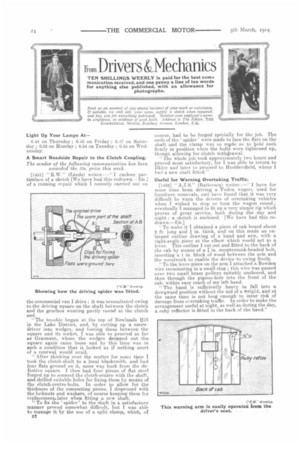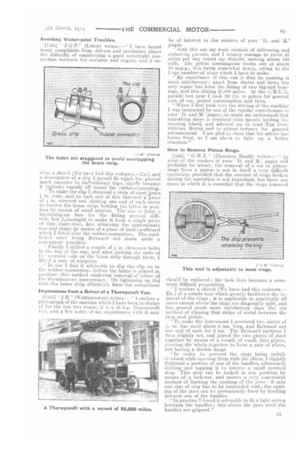from Drivers &Mechanics
Page 24

Page 25

If you've noticed an error in this article please click here to report it so we can fix it.
TEN SHILLINGS WEEKLY is paid for the best communication received, and one penny a line of ten words for anything else published, with an allowance for photographs.
Light Up Your Lamps At
6.44 on Thursday ; 6.46 on Friday ; 6.47 on Saturday; 6.52 on Monday ; 6.54 on Tuesday ; 6.55 on Wednesday.
A Smart Roadside Repair to the Clutch Coupling.
The sender of the followin4 communication has been awarded the Ws. prize this week.
[1451] " II.W." (Lbeds) writes :—" I enclose particulars of a sketch [We have had this redrawn.
of a running repair which I recently carried out on the commercial van I drive ; it was necessitated owing to the driving square on the shaft between the clutch and the gearbox wearing partly round at the clutch end.
"The trouble began at the top of Newlaads Uill in the Lake District, and, by cutting up a screwdriver into wedges, and forcing these between the square and its socket, I was able to proceed as far as Grasmere, where the wedges dropped out the square again came loose and by this time was in such a condition that it looked as if nothing snort of a renewal would avail.
" After thinking over the matter for sorw.,-, time I look the dutch-shaft to a local blacksmith, and had four flats ground on it, some way back from the defective square. I then had four pieces of flat, steel forged up to connect.the clutch-centre with the shaft, and drilled suitable holes for fixing them by means of the clutch-centre-bolts. In order to allow for the thickness of the connecting pieces, I dispensed with the loaknuts and washers, of course keeping theru for replacement. later when fitting a new shaft. "To fix the ' spider ' to the shaft in a satisfactory manner proved somewhat difficult, but I was able to manage it by the use of a split clamp, which, of course, had to be forged specially for the job. The ends of the spider' were made to fame the flats on the shaft and the clamp was so mgcle as to bold each firmly in position when the bolts were tightened up, though allowing for clutch withdrawal. "The whole job took approximately two hours and proved most satisfactory, for I was able to return to Ilkley and later to proceed to Huddersfield, where I had a new shaft fitted."
Useful for Warning Overtaking Traffic.
[1452] " A.J.S." (Battersea) writes —"I have for some time been driving a 'Peden wagon, used for furniture removals, and have found that it was very difficult. 'to warn the drivers of overtaking vehicles when I wished to stop or turn the wagon round; eventually I managed to fit up a very simple rig which proves of great service, both during the day and night ; a sketch is enclosed. [We have had this redrawn,—En.] " To make it I obtained a piece of oak board about 2 ft. long and in. thick, and on this made an enlarged outline drawing of a hand and arm, with a right-angle piece at the elbow which would act as a, lever. This outline I cut out and fitted to the back of the cab by means of a in. countersunk-headed bolt, inserting a 1 in. block of wood between the arm and the woodwork to enable the device to swing freely,
"To the lever, pieceon the arm. I attached a Bowden wire terminating in a small ring ; this wire was passed over two small brass pulleys suitably anchored, and then through the pigeon-hole into the front of the cab, within easy reach of my left hand. " The hand is sufficiently heavy to fall into a dowuward position without the aid of a weight, and at the same time is not long enough to incur risk of damage from mertaking traffic. In order to make the arrangement useful at night, as well as during the day, a ruby reflector is fitted in the back of the hand." Avoiding Water-joint Troubles.
[1.153j "J.0.13." (Luton) writes :--" I have heard many complaints from drivers and mechanics about the difficulty of maintaining a good watertight connection between the radiator and engine, and I en
close a sketch [We have had this redrawn.—En.], and a description of a clip I myself fit wOich has proved much superior to thetordinary type, chiefly because it tightens equally all round the rubber-coeneetien. " To make the clip I obtained a strip of sheet brass ) in wide, aud to each end of this fastened a piece
4 •
of in. screwed rod, slotting one end of each screw to receive the brass ship, holding the latter in position by means of small setpins. The cap to form ,ts tightening-up face for the fitting pi Urea difficult, but I,managed to make it from a single piece of thin sheet-steel, first obtaining the approximate size and shape in" means of a. piece of bent cardboard which I fitted over the rubber connection. The cardbawd after being flattened out made quite a convenient template. " Finally T drilled a couple of in. clearance holes in the top of the cap, and after putting the ends
serewed rods on the brass strip through them, I fitted a pair of, wingnuts.
" In use I find it advisable to slip the clip on to the rubber connection—before the latter is placed in position—this method rendering removal of either o4 the thumbscrews unnecessary. On tightening up thci nuts the brass strip effectively fixes the connection!
Impressions from a Driver of a Thornyerolt Van.
[1454] "JR." (Walthamstow) writes :—" I enclose a photograph of the machine which I havebeen in chargo of for the last two years ; it is a 16 h.p. Thornycroft etel, and a few notes of my experiences with it may
be of interest to the readers of your 'D. and M.' pages.
" te'ith this ear my work consists of delivering and codectaig parcels, and I usually manage to cover .50 miles per nay round my district, making about 150 calls. The petrol consumption works out at about to m.p.g., this being somewhat heavy, owing to the lerge numberof stops which I have to make.
"My experience of this van is that its running is most satisfactory ; apart from chains and tires, the only repair has been the fitting of two big-end bearings, and this during 23,000 miles. At the U.M.U.A. parade last year I took £6 13s. in prizes for general (ewe of car, petrol consumption and tires.
" When I first took over the driving of the machine I was instructed by one of the regular contributors to your 'I). and M.' pages ; he made me understand that something more is required than merely holding tlei steering wheel, and advised tile to read TUE CometEnctiae Moroa and to attend lectures for general advancement. I am glad to state that his advice has borne fruit, as T am about to take up a better situation."
How to Remove Piston Rings.
[1455] " G.W.E." (Thornton Heath) writes :—" As most of the readers of your D. and M.' pages will probably be aware, the removal of a set of pistonrings from a piston is not in itself a very difficult operation, provided that the number of rings broken during the operation is not important, but there are cases in which it is essential that the rings removed should be replaced ; the task then becomes a somewhat difficult proposition.
'1 enclose a sketch [We have had this redrawn.— ED.] of a simple tool which greatly facilitates the removal of the rings; it is applicable in practically all eases except where the rings are diagonally split, and has proved much more satisfactory than the old method of slipping thin strips of metal between the ring and piston. "To make the instrument I procured two pieces of -Ain. bar steel a-bout 6 ins, long, and flattened out one eud. of each for 2 ins. The flattened portions I then slightly set, and joined the two pieces of steel eogether by means of a couple of small, thin plates, riveting the whole together to form a pair of pliers, but having a double hinge.
In order to prevent the rings being unduly strained while opening them with the pliers, islightly flattened a portion of one of the handles, afterwards drilling and tapping it to receive a small screwed stop. This stop can be locked in any position by means of a lock-nut, and proves a. very convenient method of limiting the opening of the jaws ; if only one size of ring has to be contended with, the opening of the jaws can be permanently fixed by bending inwards one of the handles. "In practice found it advisable to fit a light spring between the handles ; this closes the jaws until the handles are gripped."


























